heater SATURN ASTRA 2009 Owners Manual
[x] Cancel search | Manufacturer: SATURN, Model Year: 2009, Model line: ASTRA, Model: SATURN ASTRA 2009Pages: 314, PDF Size: 1.94 MB
Page 37 of 314
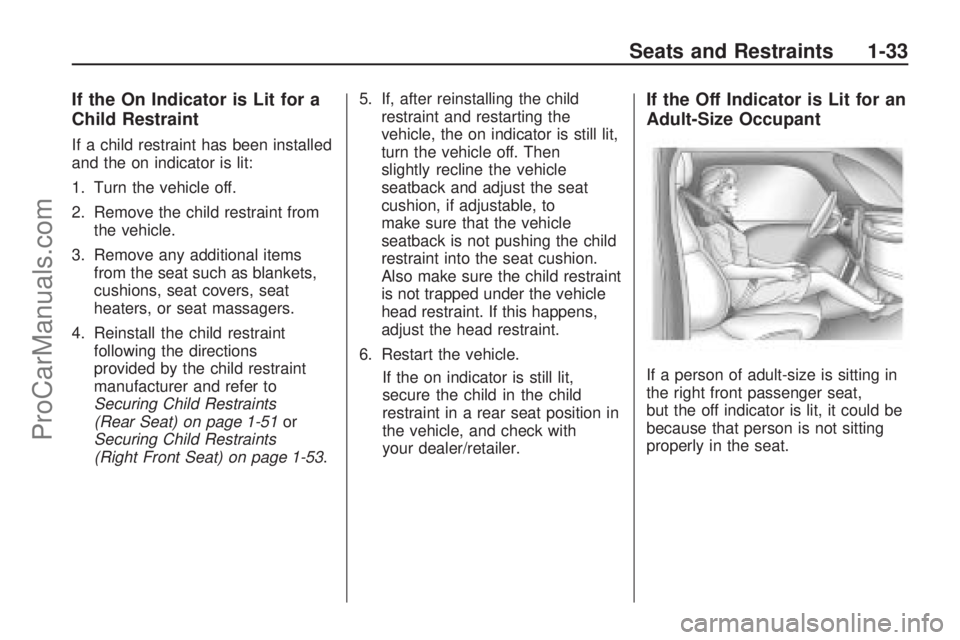
If the On Indicator is Lit for a
Child Restraint
If a child restraint has been installed
and the on indicator is lit:
1. Turn the vehicle off.
2. Remove the child restraint from
the vehicle.
3. Remove any additional items
from the seat such as blankets,
cushions, seat covers, seat
heaters, or seat massagers.
4. Reinstall the child restraint
following the directions
provided by the child restraint
manufacturer and refer to
Securing Child Restraints
(Rear Seat) on page 1-51or
Securing Child Restraints
(Right Front Seat) on page 1-53.5. If, after reinstalling the child
restraint and restarting the
vehicle, the on indicator is still lit,
turn the vehicle off. Then
slightly recline the vehicle
seatback and adjust the seat
cushion, if adjustable, to
make sure that the vehicle
seatback is not pushing the child
restraint into the seat cushion.
Also make sure the child restraint
is not trapped under the vehicle
head restraint. If this happens,
adjust the head restraint.
6. Restart the vehicle.
If the on indicator is still lit,
secure the child in the child
restraint in a rear seat position in
the vehicle, and check with
your dealer/retailer.
If the Off Indicator is Lit for an
Adult-Size Occupant
If a person of adult-size is sitting in
the right front passenger seat,
but the off indicator is lit, it could be
because that person is not sitting
properly in the seat.
Seats and Restraints 1-33
ProCarManuals.com
Page 38 of 314
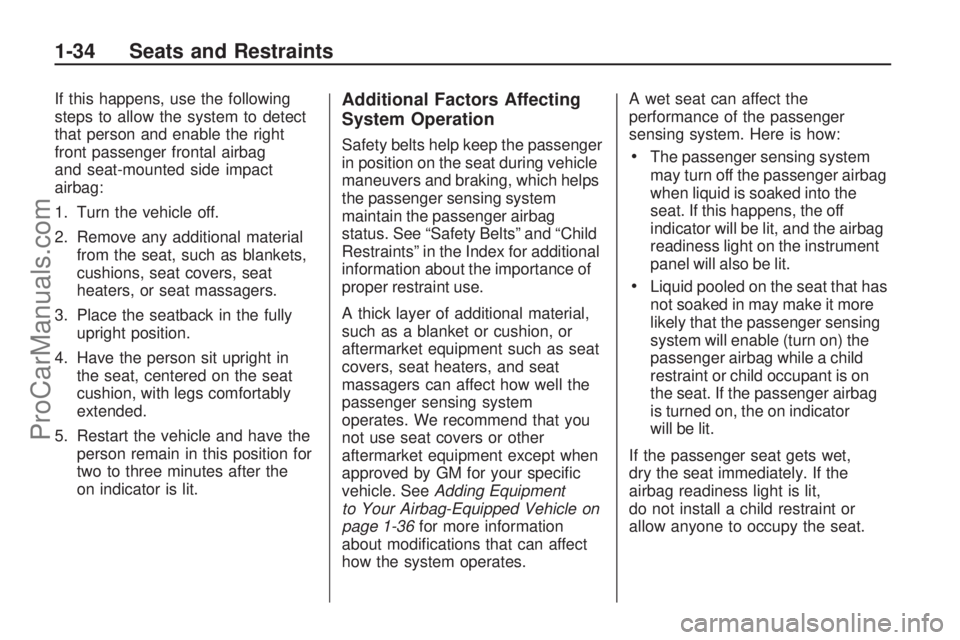
If this happens, use the following
steps to allow the system to detect
that person and enable the right
front passenger frontal airbag
and seat-mounted side impact
airbag:
1. Turn the vehicle off.
2. Remove any additional material
from the seat, such as blankets,
cushions, seat covers, seat
heaters, or seat massagers.
3. Place the seatback in the fully
upright position.
4. Have the person sit upright in
the seat, centered on the seat
cushion, with legs comfortably
extended.
5. Restart the vehicle and have the
person remain in this position for
two to three minutes after the
on indicator is lit.Additional Factors Affecting
System Operation
Safety belts help keep the passenger
in position on the seat during vehicle
maneuvers and braking, which helps
the passenger sensing system
maintain the passenger airbag
status. See “Safety Belts” and “Child
Restraints” in the Index for additional
information about the importance of
proper restraint use.
A thick layer of additional material,
such as a blanket or cushion, or
aftermarket equipment such as seat
covers, seat heaters, and seat
massagers can affect how well the
passenger sensing system
operates. We recommend that you
not use seat covers or other
aftermarket equipment except when
approved by GM for your speci�c
vehicle. SeeAdding Equipment
to Your Airbag-Equipped Vehicle on
page 1-36for more information
about modi�cations that can affect
how the system operates.A wet seat can affect the
performance of the passenger
sensing system. Here is how:The passenger sensing system
may turn off the passenger airbag
when liquid is soaked into the
seat. If this happens, the off
indicator will be lit, and the airbag
readiness light on the instrument
panel will also be lit.
Liquid pooled on the seat that has
not soaked in may make it more
likely that the passenger sensing
system will enable (turn on) the
passenger airbag while a child
restraint or child occupant is on
the seat. If the passenger airbag
is turned on, the on indicator
will be lit.
If the passenger seat gets wet,
dry the seat immediately. If the
airbag readiness light is lit,
do not install a child restraint or
allow anyone to occupy the seat.
1-34 Seats and Restraints
ProCarManuals.com
Page 40 of 314

Adding Equipment to
Your Airbag-Equipped
Vehicle
Q:Is there anything I might add to
or change about the vehicle
that could keep the airbags
from working properly?
A:Yes. If you add things that
change the vehicle’s frame,
bumper system, height, front end
or side sheet metal, they may
keep the airbag system from
working properly. Changing or
moving any parts of the front
seats, safety belts, the airbag
sensing and diagnostic module,
steering wheel, instrument
panel, roof-rail airbag modules,
ceiling headliner or pillar
garnish trim, front sensors, or
airbag wiring can affect the
operation of the airbag system.In addition, the vehicle has a
passenger sensing system for the
right front passenger position,
which includes sensors that are
part of the passenger’s seat.
The passenger sensing system
may not operate properly if the
original seat trim is replaced with
non-GM covers, upholstery or
trim, or with GM covers,
upholstery or trim designed for a
different vehicle. Any object, such
as an aftermarket seat heater or a
comfort enhancing pad or device,
installed under or on top of the
seat fabric, could also interfere
with the operation of the
passenger sensing system.This could either prevent proper
deployment of the passenger
airbag(s) or prevent the
passenger sensing system
from properly turning off
the passenger airbag(s).
SeePassenger Sensing
System on page 1-30.
If you have any questions, call
Customer Assistance. The phone
numbers and addresses for
Customer Assistance are in
Step Two of the Customer
Satisfaction Procedure in this
manual. SeeCustomer
Satisfaction Procedure on
page 12-1.
1-36 Seats and Restraints
ProCarManuals.com
Page 147 of 314

Driving and
Operating
Starting and Operating
Your Vehicle
New Vehicle Break-In.........8-2
Ignition Positions................8-2
Retained Accessory
Power (RAP).....................8-3
Starting the Engine.............8-3
Engine Heater....................8-5
Automatic Transmission
Operation..........................8-6
Manual Transmission
Operation..........................8-9
Parking Brake...................8-10
Shifting Into Park..............8-11
Shifting Out of Park..........8-12
Parking the Vehicle...........8-13
Parking Over Things
That Burn........................8-13
Engine Exhaust.................8-14
Running the Vehicle
While Parked..................8-14
Driving Your Vehicle
Driving for Better Fuel
Economy.........................8-15
Defensive Driving..............8-16
Drunk Driving....................8-16
Control of a Vehicle..........8-17
Braking.............................8-17
Antilock Brake
System (ABS).................8-18
StabiliTrak®System..........8-19
Steering............................8-20
Off-Road Recovery............8-21
Passing.............................8-22
Loss of Control.................8-22
Driving at Night.................8-23
Driving in Rain and on
Wet Roads......................8-24
Before Leaving on a
Long Trip........................8-25
Highway Hypnosis.............8-25
Hill and Mountain
Roads.............................8-26
Winter Driving...................8-27
If Your Vehicle is Stuck
in Sand, Mud, Ice,
or Snow
..........................8-29
Rocking Your Vehicle to
Get It Out.......................8-29
Loading the Vehicle..........8-30
Fuel
Fuel..................................8-34
Gasoline Octane...............8-34
Gasoline Speci�cations.....8-34
California Fuel..................8-34
Additives...........................8-34
Fuels in Foreign
Countries........................8-35
Filling the Tank.................8-36
Filling a Portable Fuel
Container........................8-37
Driving and Operating 8-1
ProCarManuals.com
Page 151 of 314
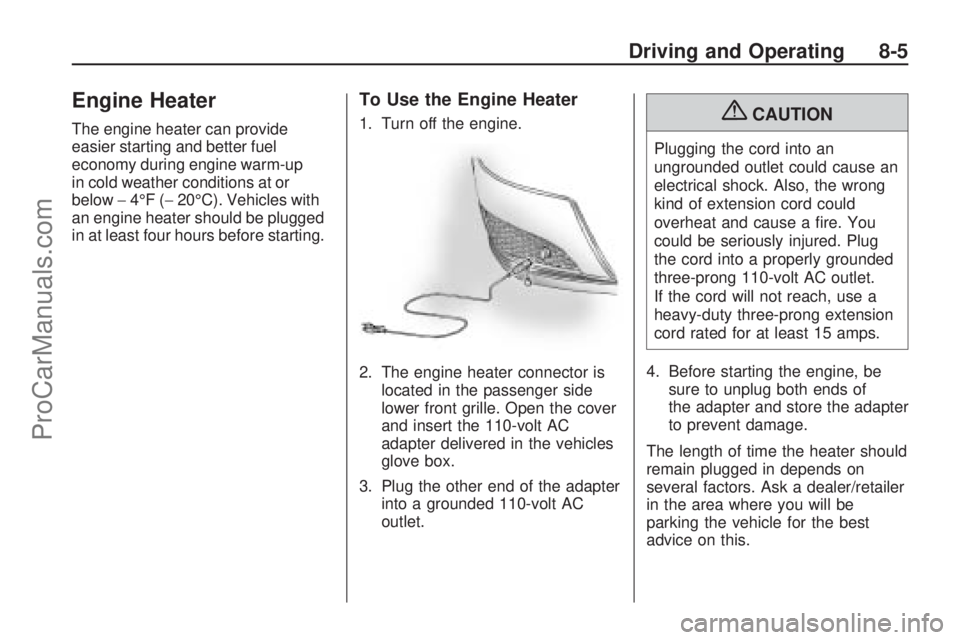
Engine Heater
The engine heater can provide
easier starting and better fuel
economy during engine warm-up
in cold weather conditions at or
below−4°F (−20°C). Vehicles with
an engine heater should be plugged
in at least four hours before starting.
To Use the Engine Heater
1. Turn off the engine.
2. The engine heater connector is
located in the passenger side
lower front grille. Open the cover
and insert the 110-volt AC
adapter delivered in the vehicles
glove box.
3. Plug the other end of the adapter
into a grounded 110-volt AC
outlet.{CAUTION
Plugging the cord into an
ungrounded outlet could cause an
electrical shock. Also, the wrong
kind of extension cord could
overheat and cause a �re. You
could be seriously injured. Plug
the cord into a properly grounded
three-prong 110-volt AC outlet.
If the cord will not reach, use a
heavy-duty three-prong extension
cord rated for at least 15 amps.
4. Before starting the engine, be
sure to unplug both ends of
the adapter and store the adapter
to prevent damage.
The length of time the heater should
remain plugged in depends on
several factors. Ask a dealer/retailer
in the area where you will be
parking the vehicle for the best
advice on this.
Driving and Operating 8-5
ProCarManuals.com
Page 197 of 314
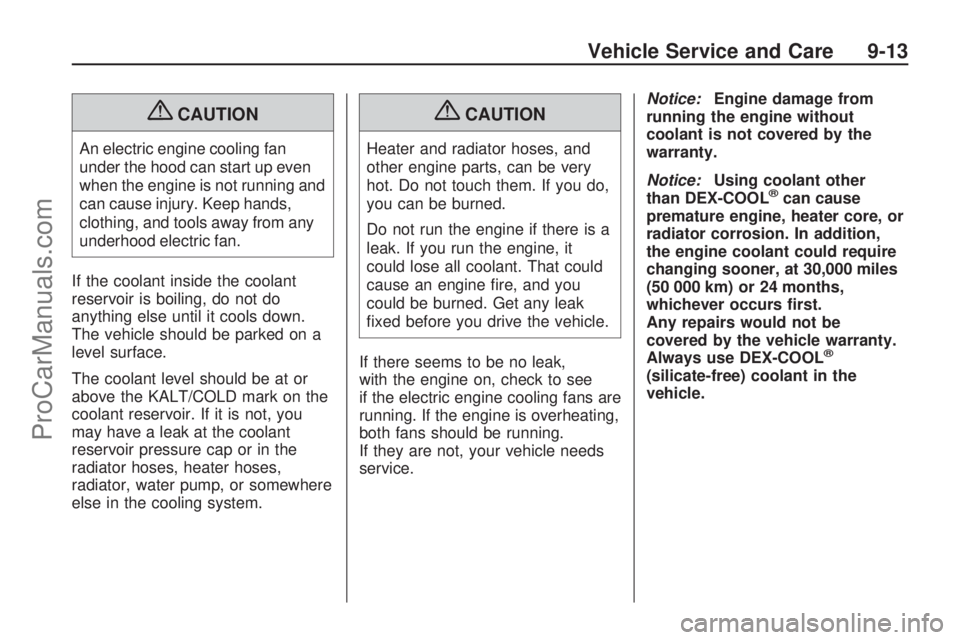
{CAUTION
An electric engine cooling fan
under the hood can start up even
when the engine is not running and
can cause injury. Keep hands,
clothing, and tools away from any
underhood electric fan.
If the coolant inside the coolant
reservoir is boiling, do not do
anything else until it cools down.
The vehicle should be parked on a
level surface.
The coolant level should be at or
above the KALT/COLD mark on the
coolant reservoir. If it is not, you
may have a leak at the coolant
reservoir pressure cap or in the
radiator hoses, heater hoses,
radiator, water pump, or somewhere
else in the cooling system.
{CAUTION
Heater and radiator hoses, and
other engine parts, can be very
hot. Do not touch them. If you do,
you can be burned.
Do not run the engine if there is a
leak. If you run the engine, it
could lose all coolant. That could
cause an engine �re, and you
could be burned. Get any leak
�xed before you drive the vehicle.
If there seems to be no leak,
with the engine on, check to see
if the electric engine cooling fans are
running. If the engine is overheating,
both fans should be running.
If they are not, your vehicle needs
service.Notice:Engine damage from
running the engine without
coolant is not covered by the
warranty.
Notice:Using coolant other
than DEX-COOL
®can cause
premature engine, heater core, or
radiator corrosion. In addition,
the engine coolant could require
changing sooner, at 30,000 miles
(50 000 km) or 24 months,
whichever occurs �rst.
Any repairs would not be
covered by the vehicle warranty.
Always use DEX-COOL
®
(silicate-free) coolant in the
vehicle.
Vehicle Service and Care 9-13
ProCarManuals.com
Page 198 of 314
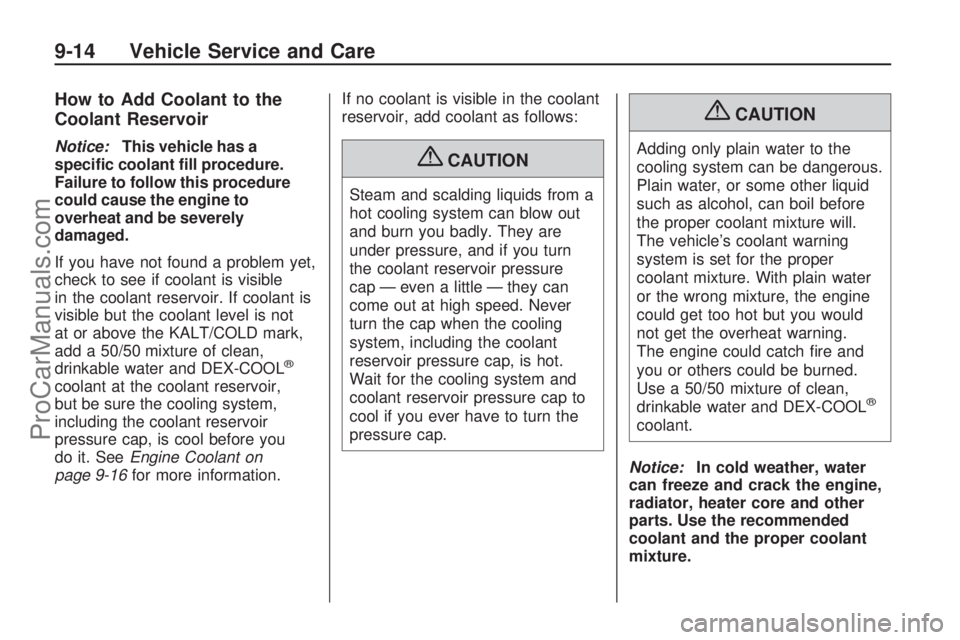
How to Add Coolant to the
Coolant Reservoir
Notice:This vehicle has a
speci�c coolant �ll procedure.
Failure to follow this procedure
could cause the engine to
overheat and be severely
damaged.
If you have not found a problem yet,
check to see if coolant is visible
in the coolant reservoir. If coolant is
visible but the coolant level is not
at or above the KALT/COLD mark,
add a 50/50 mixture of clean,
drinkable water and DEX-COOL
®
coolant at the coolant reservoir,
but be sure the cooling system,
including the coolant reservoir
pressure cap, is cool before you
do it. SeeEngine Coolant on
page 9-16for more information.If no coolant is visible in the coolant
reservoir, add coolant as follows:
{CAUTION
Steam and scalding liquids from a
hot cooling system can blow out
and burn you badly. They are
under pressure, and if you turn
the coolant reservoir pressure
cap — even a little — they can
come out at high speed. Never
turn the cap when the cooling
system, including the coolant
reservoir pressure cap, is hot.
Wait for the cooling system and
coolant reservoir pressure cap to
cool if you ever have to turn the
pressure cap.
{CAUTION
Adding only plain water to the
cooling system can be dangerous.
Plain water, or some other liquid
such as alcohol, can boil before
the proper coolant mixture will.
The vehicle’s coolant warning
system is set for the proper
coolant mixture. With plain water
or the wrong mixture, the engine
could get too hot but you would
not get the overheat warning.
The engine could catch �re and
you or others could be burned.
Use a 50/50 mixture of clean,
drinkable water and DEX-COOL
®
coolant.
Notice:In cold weather, water
can freeze and crack the engine,
radiator, heater core and other
parts. Use the recommended
coolant and the proper coolant
mixture.
9-14 Vehicle Service and Care
ProCarManuals.com
Page 200 of 314
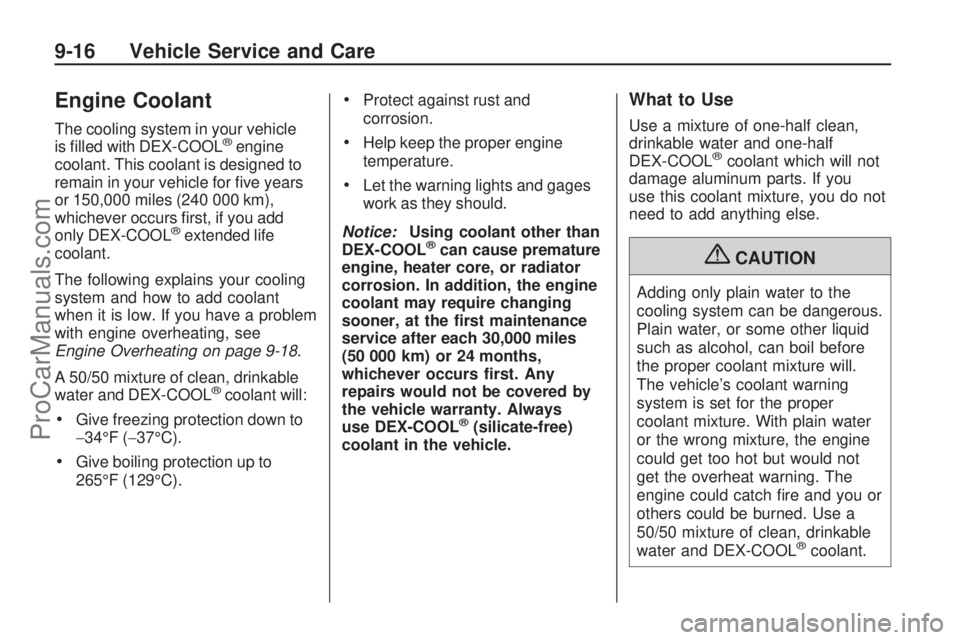
Engine Coolant
The cooling system in your vehicle
is �lled with DEX-COOL®engine
coolant. This coolant is designed to
remain in your vehicle for �ve years
or 150,000 miles (240 000 km),
whichever occurs �rst, if you add
only DEX-COOL
®extended life
coolant.
The following explains your cooling
system and how to add coolant
when it is low. If you have a problem
with engine overheating, see
Engine Overheating on page 9-18.
A 50/50 mixture of clean, drinkable
water and DEX-COOL
®coolant will:
Give freezing protection down to
−34°F (−37°C).
Give boiling protection up to
265°F (129°C).
Protect against rust and
corrosion.
Help keep the proper engine
temperature.
Let the warning lights and gages
work as they should.
Notice:Using coolant other than
DEX-COOL
®can cause premature
engine, heater core, or radiator
corrosion. In addition, the engine
coolant may require changing
sooner, at the �rst maintenance
service after each 30,000 miles
(50 000 km) or 24 months,
whichever occurs �rst. Any
repairs would not be covered by
the vehicle warranty. Always
use DEX-COOL
®(silicate-free)
coolant in the vehicle.
What to Use
Use a mixture of one-half clean,
drinkable water and one-half
DEX-COOL
®coolant which will not
damage aluminum parts. If you
use this coolant mixture, you do not
need to add anything else.
{CAUTION
Adding only plain water to the
cooling system can be dangerous.
Plain water, or some other liquid
such as alcohol, can boil before
the proper coolant mixture will.
The vehicle’s coolant warning
system is set for the proper
coolant mixture. With plain water
or the wrong mixture, the engine
could get too hot but would not
get the overheat warning. The
engine could catch �re and you or
others could be burned. Use a
50/50 mixture of clean, drinkable
water and DEX-COOL
®coolant.
9-16 Vehicle Service and Care
ProCarManuals.com
Page 201 of 314

Notice:If an improper coolant
mixture is used, the engine could
overheat and be badly damaged.
The repair cost would not be
covered by the vehicle warranty.
Too much water in the mixture
can freeze and crack the engine,
radiator, heater core, and
other parts.
Notice:If you use extra
inhibitors and/or additives in
your vehicle’s cooling system,
you could damage your vehicle.
Use only the proper mixture of
the engine coolant listed in
this manual for the cooling
system. See Recommended
Fluids and Lubricants in the
Maintenance and Limited
Warranty and Owner Assistance
Information manual.Checking Coolant
The coolant reservoir is located in
the engine compartment on the
driver’s side of the vehicle.
SeeEngine Compartment Overview
on page 9-6for more information
on location.
{CAUTION
Turning the coolant reservoir
pressure cap when the engine
and radiator are hot can allow
steam and scalding liquids to blow
out and burn you badly. Never
turn the coolant reservoir pressure
cap – even a little – when the
engine and radiator are hot.
The vehicle must be on a level
surface. When your engine is cold,
the coolant level should be at
the KALT/COLD line.
Do not over�ll the coolant reservoir.
Too much coolant can result in
an over�ow condition when the
�uid is hot.
Vehicle Service and Care 9-17
ProCarManuals.com
Page 203 of 314

Notice:If the engine catches �re
because of being driven with
no coolant, your vehicle can be
badly damaged. The costly
repairs would not be covered by
the vehicle warranty.
If No Steam Is Coming From
Your Engine
An engine coolant temperature
warning can indicate a serious
problem. SeeEngine Coolant
Temperature Warning Light on
page 4-18.
If you get an engine coolant
temperature warning, but see or hear
no steam, the problem may not be
too serious. Sometimes the engine
can get a little too hot when you:
Climb a long hill on a hot day.
Stop after high-speed driving.
Idle for long periods in traffic.If you get the engine coolant
temperature warning with no sign of
steam, try this for a minute or so:
1. If your air conditioner is on,
turn it off.
2. In heavy traffic, let the engine
idle in N (Neutral) while
stopped. If it is safe to do so,
pull off the road, shift to P (Park)
or N (Neutral) and let the
engine idle.
3. Turn on your heater to full hot at
the highest fan speed and open
the windows as necessary.
If you no longer have the overheat
warning, you can drive. Just to
be safe, drive slower for about
10 minutes. If the warning does not
come back on, you can drive
normally.If the warning continues and you
have not stopped, pull over,
stop, and park your vehicle
right away.
If there is still no sign of steam,
you can idle the engine for
three minutes while you are parked.
If you still have the warning, turn
off the engine and get everyone out
of the vehicle until it cools down.
You may decide not to lift the hood
but to get service help right away.
Vehicle Service and Care 9-19
ProCarManuals.com